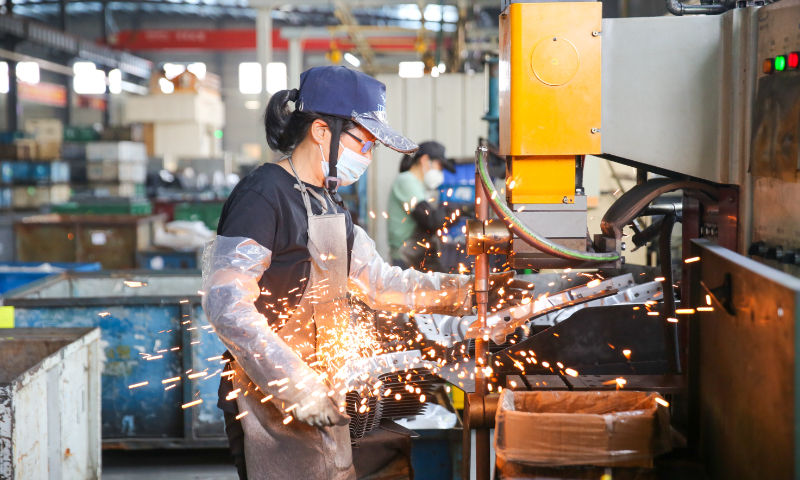China's CPI edges up 0.1% in June, bolstered by the government's pro-growth stimulus package: NBS - Global Times
China's CPI edges up 0.1% in June, bolstered by the government's pro-growth stimulus package: NBS

Workers manufacture auto parts at a factory in Rugao, East China's Jiangsu Province, on June 25, 2025. Photo: VCG
China's national consumer price index (CPI) rose by 0.1 percent year-on-year in June, reversing four months of declines. The core CPI (excluding food and energy) continued to rise in June, according to the latest data released by the National Bureau of Statistics (NBS).
Analysts attributed the reverse in consumer price decline to the government's package of fiscal and monetary policy stimulus to boost domestic consumption.
The core CPI climbed in June, reaching 0.7 percent, setting a new high in nearly 14 months. The CPI's shift to positive growth was driven by a recovery in prices of broad industrial consumer goods, which reduced the downward impact on the year-on-year CPI by approximately 0.18 percentage points last month.
"In June 2025, policies to expand domestic demand and boost consumption continued to take effect, with the CPI rising by 0.1 percent year-on-year, reversing the previous month's decline, mainly due to the recovery in the prices of industrial consumer goods," NBS chief statistician Dong Lijuan said on Wednesday. The year-on-year decline of the prices narrowed from minus 1.0 percent in May to minus 0.5 percent in the month.
Energy prices, influenced by global oil price volatilities, dropped 1.0 percentage point, easing CPI's downward pressure by 0.08 percentage points. Gold and platinum jewelry prices surged 39.2 percent and 15.9 percent, respectively, boosting CPI by 0.21 percentage points in June.
The effect of government's stimulus policies to boost consumption is also seen from the rising e-commerce logistics index, an indicator of logistics operations in China's e-commerce sector. The e-commerce logistics index stood at 111.8 in June, up 0.2 points from May, marking a month-on-month growth for four consecutive months in June, according to the China Federation of Logistics and Purchasing.
Driven by the government's consumer goods trade-in policy and the promotions by e-commerce platforms, consumer enthusiasm for online shopping surged in June. Enterprises reported that the order volume and user activity reached record highs, the federation said on Wednesday.
Meanwhile, the producer price index (PPI) in June dropped by 0.4 percent month-on-month, unchanged from May, but fell 3.6 percent year-on-year, with the decline widening by 0.3 percentage points.
Dong attributed the PPI's month-on-month decline to seasonal declines in raw materials prices, increased green energy supply dragging down energy prices, and the pressure on exports.
High summer temperatures and rainy days slowed construction, resulting in a 1.8-percent drop in ferrous metal processing prices and a 1.4-percent drop in non-metallic mineral products, which together dragged PPI down by 0.18 percentage points, said Dong.
Solar, wind, and hydropower growth in China helped lower power generation costs, reducing electricity and heat production prices by 0.9 percent. Weaker coal demand, with stable supply and ample stocks, led to a 5.5 percent drop in coal prices.
"The three aforementioned industries collectively dragged down PPI by 0.15 percentage points," said Dong.
And, Dong noted that prices for industries with a relatively high proportion of exports were facing pressure.
"Slowing global trade and uncertainties weighed on export-reliant industries, with computer and electronics manufacturing prices down 0.4 percent, electrical machinery down 0.2 percent, and textiles down 0.2 percent," said Dong.
Thanks to the government's consumption-boosting policies, the rising demand for quality goods lifted daily necessities and clothing prices by 0.8 percent and 0.1 percent year-on-year, respectively. Craft and ceremonial products prices rose 13.1 percent, with silk processing up by 1.2 percent, and sports goods up by 0.7 percent.
The accumulation of new growth drivers has led to a year-on-year increase in prices in some high-tech industries, including integrated circuit testing (3.1 percent), wearable devices (1.4 percent), and aerospace equipment (1.1 percent).
Global Times
You may also like...
Diddy's Legal Troubles & Racketeering Trial

Music mogul Sean 'Diddy' Combs was acquitted of sex trafficking and racketeering charges but convicted on transportation...
Thomas Partey Faces Rape & Sexual Assault Charges

Former Arsenal midfielder Thomas Partey has been formally charged with multiple counts of rape and sexual assault by UK ...
Nigeria Universities Changes Admission Policies

JAMB has clarified its admission policies, rectifying a student's status, reiterating the necessity of its Central Admis...
Ghana's Economic Reforms & Gold Sector Initiatives

Ghana is undertaking a comprehensive economic overhaul with President John Dramani Mahama's 24-Hour Economy and Accelera...
WAFCON 2024 African Women's Football Tournament

The 2024 Women's Africa Cup of Nations opened with thrilling matches, seeing Nigeria's Super Falcons secure a dominant 3...
Emergence & Dynamics of Nigeria's ADC Coalition

A new opposition coalition, led by the African Democratic Congress (ADC), is emerging to challenge President Bola Ahmed ...
Demise of Olubadan of Ibadanland
Oba Owolabi Olakulehin, the 43rd Olubadan of Ibadanland, has died at 90, concluding a life of distinguished service in t...
Death of Nigerian Goalkeeping Legend Peter Rufai

Nigerian football mourns the death of legendary Super Eagles goalkeeper Peter Rufai, who passed away at 61. Known as 'Do...





